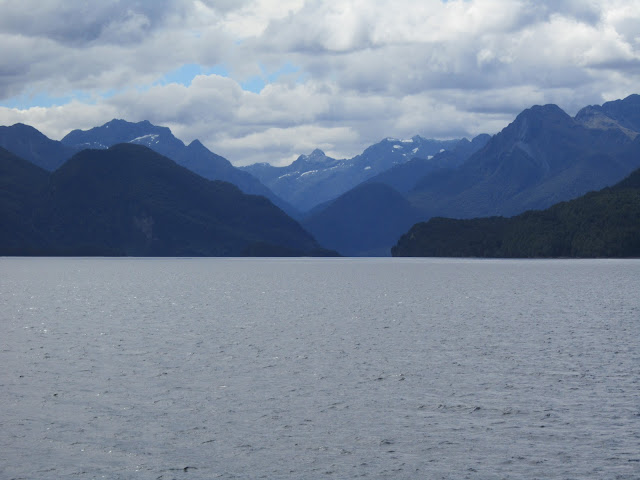Day 3 of the Milford Track is the highlight of the walk and also the most difficult, as you to scale the peak at MacKinnon Pass and then hike all the way back down to sea level. We had 14 km ahead of us and headed out fairly early. The day started off cloudy and the first few hours were straight up hill through fog. Having already hiked 21.5 km the previous two days, the 30 lb packs we were lugging up the mountain began to feel a little heavy. After about an hour and a half, the path gets increasingly steep as it zigzags upwards. Just as we began to doubt whether all this
effort would be rewarded, we looked up and peeking through the clouds was the top of a mountain. It was a mystical and breathtaking sight.
effort would be rewarded, we looked up and peeking through the clouds was the top of a mountain. It was a mystical and breathtaking sight.
 |
| This was our first glimpse |
 |
| Dana emerging from the clouds |
We made it to MacKinnon Pass at the perfect time, as the sun was out and the clouds were beginning roll away. From what we hear, this is a rare event at the peak given that it rains 300 days a year and the peak is often under significant cloud cover. To say it was an incredible view is an understatement. The pictures help to tell the story, but check out the videos to get the 360 degree perspective.
McKinnon Pass is noted to have best toilet view in Fiordland. Think that might not be enough credit…..Anyone found a better toilet view in the world?
Videos:
View at the top. Note it is really windy! Yes, that is snow up there and it’s summer in NZ.
http://youtu.be/Ikap-n6E9-k
http://youtu.be/Ikap-n6E9-k
Reinaker went for a quick dip at the little pond at the top. Given that it was 40 degrees and windy, this was an insane idea (others laughing in the background felt the same). He dried off quickly, changed clothes and said he felt great afterwards. Gauging from his reaction…..the water was pretty cold. I certainly wasn’t tough enough to do the same.
http://youtu.be/FI6iAtKsV4I
That wasn’t the end of the fun and adventure for day three. We headed down the mountain which is actually tougher on the legs than going up. We passed some beautiful sights on the way down. There is an optional 1.5 hour trip to Sutherland falls a few km before the hut. After hiking 6 hours, it was a tough decision to tack on an extra hike at this point. However we heard that it was the longest waterfall in New Zealand and you could walk behind it, so we left our packs on the trail and took the detour (much easier hiking without having to lug 30 lb packs with us!).
The waterfall was well worth the extra hike. The pictures can’t capture the true height, but it was intensely powerful. There was spray from the waterfall reaching a couple hundred feet away. Checking out the pool of water below the waterfall, it wasn’t really swim worthy as it couldn’t have been more than a foot deep. And this wasn’t a waterfall that you wanted to be directly under. I’m pretty sure that would kill a person. However Reinaker and I walked along the rocks and stood directly behind the waterfall. It was like being in a hurricane. Water was pelting you from all directions,with insanely loud and powerful winds and you could barely see with all the water coming at you. This description probably doesn’t sound appealing to most of you…..but it was awesome.At certain points there was so much water around that I would look in a certain direction and my vision had a circular rainbow. Not just a half circle rainbow, but a full 360 degrees rainbow wherever I looked. Maybe someone that knows science can explain that one.


















































